Guitar cables can cost $8, or they can cost $200. What’s the difference?
Contents
Lord It’s So Complicated! (not)
How Much Freekin’ Frequency Do You Need?
.
Lord It’s So Complicated! (not)
We’ve heard it all before.
 To have the ultimate guitar tone, we must seek the ultimate technology, right? Because the ultimate guitar tone is so complicated, so elusive, that to achieve it requires trained scientists doing amazing things. Right?
To have the ultimate guitar tone, we must seek the ultimate technology, right? Because the ultimate guitar tone is so complicated, so elusive, that to achieve it requires trained scientists doing amazing things. Right?
We hear things like:
“Oxygen free copper”. “Single stranded wire”. “Gold plating”. “Copper tipped”. “Less resistance”. And…our favorite…”Time correction”! (Einstein is rolling over in his grave…laughing).
These things sound glorious indeed. And, of course, there are all kinds of technical studies, research, experiments, measurements, and explanations to prove that it’s all true.
And, of course, all of this amazing technology is expensive. But it’s all worth it, you know, to prevent that dredded “tone suck”.
Right?
 .
.
.
Mr. C
There is one thing, and one thing only, that can affect how a guitar cable sounds.
Capacitance. Let’s call it “C” (the engineers do)
All cables have a certain amount of C. The longer the cable, the more C it has. A particular cable will have “C per foot”. You can multiply “C per foot” times the length of the cable, and you get the total C of that cable. (You don’t ever need to do this, we just wanted you to know that a cable’s C is based on its length.)
Why is C important?
If you get too much C, you lose high end frequency response: aka “treble”.
THIS IS ALL TONE SUCK IS: LOSS OF TREBLE.
It is caused by too much cable capacitance, and ONLY too much cable capacitance. Nothing more, nothing less.
Can it really be this simple?
NOTE: There is one exception. If you have:
- A guitar with enough inductance (usually this means a powerful pickup with a higher impedance), AND
- A cable with sufficient capacitance (usually a longer cable),
… there can be a slight bump in the high end treble. It is subtle, and has nothing to do with cost, quality, or brand of the cable. Engineers call this an “LC resonance” (L for inductance, C for capacitance). This is the main reason why folks think cables can make a difference.
Wire is Wire
My wife and I like to tell this story.
Back when I went to college (the first time), my girlfriend (now my wife) had just gotten a nice Fisher stereo for high school graduation. I, being the boyfriend, was tasked with wiring that sucka creatively into a cramped dorm room.
So off we went to the hardware store in the teaming metropolis of downtown Laurinburg NC.
We poked around, a bit confused as to what to get. I asked the sales guy “Can we use this lamp cord here, or do we have to get speaker wire?” (This was before I had an electrical engineering degree.)
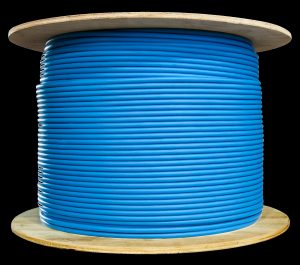 His response was classic:
His response was classic:
“Wire is wire.” (pronounced with a wise southern drawl…”wahr”…rhymes with “bar”).
I did not know then, but on that day, he knew more about the physics of electricity than I did.
(Technically, wire is not wire when it comes to speakers. You need a heavier gauge to handle the current. But his point was that plain old lamp cord was fine. And it was.)
Now, wire has resistance, inductance, and a few other things that rarely apply to audio signals. But capacitance is the only thing that matters with guitar cables.
OK, OK…we have all heard “expert” folks say otherwise, BUT…
.
- We have never heard a plausible explanation for anything otherwise.
- We have never seen anyone demonstrate otherwise in a blindfolded test, or with any kind of credible measurement.
- It defies the laws of physics to say otherwise (this is the biggie).
- We more than welcome anyone to prove us wrong in a blindfolded A/B test.
NOTE: Nobody ever has. In fact, we have been offering a standing challenge:
Come to our facility with any guitar cable you want (of 12 feet or more). Try to tell the difference between your cable and our $10 cable (of 12 feet or more) … while blindfolded. We’ll give you 3 to 1 odds. You must put up $100, so you can win $300! But you gotta tell the difference correctly while blindfolded, 5 times in a row!
We’re waiting…
.
But you say “what about resistance, doesn’t that matter?”
No. Not for guitar cables.
How can this be?
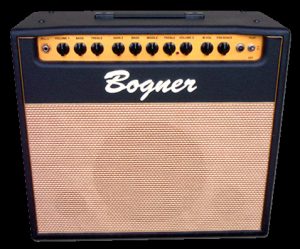 The input impedance (resistance really) of the typical guitar amp is REALLY high: usually around 1,000,000 ohms. So nobody gives a rat’s ass whether your cable has 1 ohm of resistance or 10 ohms. The amp’s input impedance totally and absolutely swamps that tiny little cable resistance.
The input impedance (resistance really) of the typical guitar amp is REALLY high: usually around 1,000,000 ohms. So nobody gives a rat’s ass whether your cable has 1 ohm of resistance or 10 ohms. The amp’s input impedance totally and absolutely swamps that tiny little cable resistance.
So the next time somebody tries to tell you their cable has less resistance, ask him why that matters. They without a doubt will tell you it lets more signal get thru. So then ask him how that can possibly be true when the amp has a 1,000,000 ohm input resistance. (This is the fun part…they will have to get creative.)
Mr. Z
Is C really all that counts?
Well, not exactly. There is one more factor that affects a cable’s sound. But this has nothing to do with the cable. It has to do with what is putting the guitar signal into the cable.
We’re talking about:
Output impedance. Let’s call it “Z” (the engineers do)
This is the output impedance of whatever is putting the signal into the cable. It can be a pickup, a pedal, etc. (Z is like the electrical resistance of the output).
It’s Simple: C x Z
So we have 2 factors: C and Z: Capacitance and output impedance.
 In fact, C multiplied times Z is what is important.
In fact, C multiplied times Z is what is important.
Here’s the deal:
C x Z determines how much treble (high end) you can get thru your cable. If C x Z goes up, there is less high end. And …
If C x Z gets too high…you guessed it…TONE SUCK.
On the other hand:
The LOWER C x Z, the more treble can come thru the cable.
This is not say more and more treble is better. After you get enough, getting more won’t help. An electric guitar only produces high frequencies up to about 10kHz. So up to 10kHz is all the treble you need. (Compare this to someone with great hearing, who can hear 16kHz or more. Dogs are even better!)

So basically, to avoid tone suck, we just have to manage C … the capacitance of our cables.
For example:
If you double the length of your guitar cabling, by adding pedals, longer cords, etc., you double the C. So, in return, you must cut Z in half to avoid changing the treble response of your cable. (Don’t worry, it’s easy to do, just keep reading…)
Again, this does not mean that smaller C, or Z, or C x Z is better. It just means you’ve got to have a low enough C x Z to sound good. C x Z must be low enough to achieve enough treble response (10kHz or more) to avoid tone suck. (Too low can be a problem too, see below).
 .
.
Now that we know the importance of C x Z, and how it must stay below a certain level, let’s talk more about Mr. Z (output impedance). He’s very important, because when we start having all manner of pedals and cables strewn about, C gets pretty high. And Mr. Z is the only guy that’s going to help us. And he is good at it.
.
To put it simply, guitar pickups are “high Z” (high impedance). They measure pickup Z in ohms (resistance). Generally, pickups run from about 6 kohm to 14 kohm (6,ooo to 14,000 ohms).
So, with high Z guitar pickups, to get full treble response from the guitar, guitar cables have typically been “low C” (low capacitance, so C x Z can be low enough).
So, you may ask, why did tone suck happen?
A Little Tone Suck History
A Suck-Free Time
We didn’t always have tone suck. There was a suck-free time when everybody did as they pleased, and everybody was happy.
.
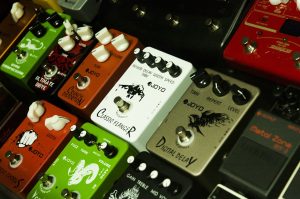 But then along came the stompbox.
But then along came the stompbox.
Sometime in the 1960’s, folks started using these gimmicky little things, which caused them to use more cables. They had a cable to the pedal, and then another cable from the pedal to the amp. If you had more than one pedal, you also had cables between the pedals.
.
All those cables add up, meaning their C’s add up. So with more and more C, folks started to notice a loss of treble. And they weren’t happy.
(They didn’t know what to call this phenomenon then. But we are more clever now, so we it “tone suck”.)
The Fix
So what happened next?
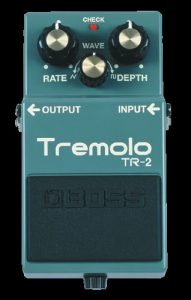 Voila!!! The buffered pedal was invented. This means they put a low-Z output circuit in the pedal so it could drive more cable C without tone suck, even when the effect is turned off!
Voila!!! The buffered pedal was invented. This means they put a low-Z output circuit in the pedal so it could drive more cable C without tone suck, even when the effect is turned off!
Brilliant.
How much more C can a pedal drive?
As we said before, the output Z of a guitar pickup is usually 5 kohm or more. The output Z of a buffered pedal is at MOST 2 kohm (usually less).
So, generally speaking, a buffered pedal can drive at least 3 times more cable than a guitar pickup.
.
NOTE If you use a battery with a buffered pedal, you must unplug the input cable to preserve battery life. This is because he circuit is active even when the effect is turned off. (This is just another reason why using batteries is a pain in the ass.)
.
Buffered vs True Bypass
So what is this “buffered pedal” of which we speak? Are all pedals buffered today?
 No. Through the 70s and 80s, to prevent tone suck, most all pedals were buffered. But then the 90s came along, and non-buffered pedals made a came back, because some folks claimed that buffers affect their sound. We call these folks “tone freekz”.
No. Through the 70s and 80s, to prevent tone suck, most all pedals were buffered. But then the 90s came along, and non-buffered pedals made a came back, because some folks claimed that buffers affect their sound. We call these folks “tone freekz”.
Non-buffered pedals are now known as “true bypass”. When off, a true bypass pedal has no low Z circuit driving the cable. The input and output of the pedal are shorted together, as if there were no pedal there at all.
.
NOTE Even true bypass pedals are buffered when the effect is turned on, but don’t tell the tone freekz this.
.
But for 99% of the free world, having all-true-bypass pedals is not a good idea. Because if all the pedals are turned off, the total amount of cable from guitar, through the pedals, and all the way to the amp, gets added together for the total C. So all-true-bypass users must be very careful managing their cable C.
 Plus, contrary to what tone freekz say, using just a few buffers is not really noticeable.
Plus, contrary to what tone freekz say, using just a few buffers is not really noticeable.
So who do you believe? As always, try it for yourself. Can you tell the difference between one buffer and no buffer?
 How about 2? 3?
How about 2? 3?
Blindfolded?
We doubt it. So we say “use a buffer”. Then you are free to do pretty much anything you want with your cabling.
.
What To Do?
.
Limit Your Buffers
But true bypass pedals do come in handy. They can help you limit the number of buffers in your total signal chain. Why is this important?
There is no such thing as a circuit with zero distortion and zero noise. Nobody we know of can hear the effect of one buffer, but if you get too many buffers, the noise and distortion add up, and you may start to notice.
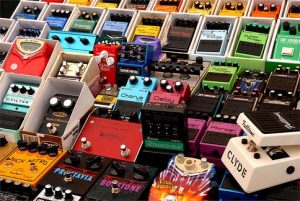 The ideal situation is to have one buffered pedal in each signal chain (pedal chain), and have the rest be true bypass. That way your signal only gets processed by one buffer. If you have 20 pedals, some “experts” will look down and say “wow, you’re killing your signal”. But if 19 are true bypass, and 1 is a buffer, it will sound great. That 1 buffer will shove sparking treble through all the other stuff just fine.
The ideal situation is to have one buffered pedal in each signal chain (pedal chain), and have the rest be true bypass. That way your signal only gets processed by one buffer. If you have 20 pedals, some “experts” will look down and say “wow, you’re killing your signal”. But if 19 are true bypass, and 1 is a buffer, it will sound great. That 1 buffer will shove sparking treble through all the other stuff just fine.
So 1 buffer is ideal. But sometimes that’s not easy. We may have a lot buffered effects pedals that we love, and we ain’t giving em up.
So just do your best. A good rule of thumb is to try to limit the number of buffers to 5-6. With that many, most all folks can hear no compromise of their sound. This includes your entire signal chain, effects loop included.
You can try more. Just use your ears. Every now and then, plug your guitar straight into your amp, with no pedals, just to see if your pedal rig is costing you any noticeable sound quality. If you have been using too many buffers, this could be an eye opening experience.
How Much Freekin’ Frequency Do You Need?
You don’t really need to know this, but we’ll throw it in for the techie folks.
So how much high-end frequency response do we need to avoid tone suck?
 The best human hearing can detect is about 20 KHz. (A dog can hear 45 kHz, so they have to use ulta-low C cables and ultra-low Z buffers.)
The best human hearing can detect is about 20 KHz. (A dog can hear 45 kHz, so they have to use ulta-low C cables and ultra-low Z buffers.)
A guitar with single coil pickups (like a Stratocaster) has the highest frequency response. They can put out harmonic content up to about 10 KHz. Humbucker axes may do only about 6-8 kHz.
So the goal is usually to ensure the frequency response of a guitar rig is 10 kHz or more. If we do that, we should have no tone suck. We should hear all the sound the guitar has to offer.
With no buffer involved, just the pickup in your ax, 10 kHz is usually accomplished with a cable of 20 feet or less.
.
NOTE: Active pickups, those that require a battery, are already a buffer, and will probably drive 60 feet or more of cable.
.
But trying to achieve lower and lower cable capacitance, to achieve higher and higher frequency response, is useless, even harmful.
The guitar is going to put out at most 10 kHz, so there is no benefit to going past that. Plus, ultra-low C cables are prone to microcphonics (handling noise). They can also have a frequency response so high that AM radio stations can start to down-modulate in your rig and creep into your sound.
But, sure as shooting, there will be sales folks trying to sell you expensive cables that are “lower in capacitance”. Unless you plan to drive 50 feet of cable with a passive guitar pickup, with no buffer pedal, there is no need to even consider those. And if you do, you are inviting other problems.
Bottom Line: Don’t worry about it cable length, capacitance, output impedances, frequency response. Just make sure you have at least one buffered pedal, and forget about it.
Don’t Fall For It
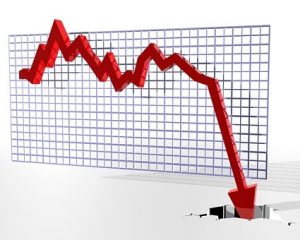 We risk bringing the US economy to its knees by telling you this, but you really ought to know.
We risk bringing the US economy to its knees by telling you this, but you really ought to know.
Be careful out there.
Guitar players have budgets, and they don’t want to spend more than they need to. But sales folks and marketers are constantly trying to complicate the tone issue, just to get you to buy something expensive. And they can be VERY persuasive. And sound VERY knowledgeable.
You will hear that tone suck is this. Tone suck is that. You have too many pedals, too much resistance in your connections, too many ducks flying over your rig, etc. You must boost this, isolate that, invoke loop switchers, enhance, time correct, and…most of all…spend.
Oh, you gotta SPEND. Then spend some more.
And we do. Because we are addicted to great tone, and in our naivety, we will do anything we think will make it even the slightest bit better.
We’ve even seen guitar cable ads that say “cables are the most important part of your sound”.
What? You mean I wasted all that money on a $3,000 tube amp, and plethora of $200 stompboxes, when I should have been putting that money towards expensive cables???!!!
I wasted all that money on a $3,000 tube amp, and plethora of $200 stompboxes, when I should have been putting that money towards expensive cables???!!!
.
Geez Louise. Please. As Tom said … “stop jammin’ me”.
.
But hey, sales hype works. We can’t tell you how many PedalSnake customers we’ve talked to that have spent more on their cables than their amp.
 .
.
So just remember, it’s not complicated. It’s simple. It’s just C x Z. And if that gets outa whack, you’ll hear it. You’ll lose treble response. It will be obvious.
Or better yet, just get a stinkin’ buffered pedal and forget about it.
(Well, OK, you may need more than one. If you have an effects loop, slap a buffered pedal in that pedal chain too.)
If you hear noise, there are clever cost-effective ways to deal with that too. See PedalSnake’s Guitar Noise Manual.
.
Our Recommendation
Technically, the signal quality of your cabling is not the only factor to the total “sound”. There is also noise to consider. To deal with this, traditional guitar cables are coax cables, meaning they have a signal wire surrounded by a shield (sometimes called a “screen”).
The shield is there to reject noise. There are different kinds of shields, even double shields. But in our experience, these are not important considerations when purchasing a cable.
Why?
As long as it is not damaged, even the most basic shielded cable is generally the last place noise will enter into your signal path. A noise source strong enough to penetrate the shield of your cable is going to find much easier paths to your ears; namely, your thru your pickups, high-gain electronics, or your power source. Things of this nature will dictate your rig’s “noise floor”, not your cable (see our Guitar Noise Manual).
You can find a lot being said in the cable market about shields. Again, we think fancy shields are mainly marketing hype. But as always, let your ears be the judge.
If you encounter an expensive cable with a fancy shield, try to compare it to a modest-cost cable. We don’t think you will hear any difference.
Now, it may be possible to reveal a difference with a more severe test. Try holding the cables up against a light dimmer. An even more severe test: Wrap the cables around an old electric drill, where you can see sparks in the motor.
Of course, these are not things encountered in normal life. In normal life, the cable is the last thing that will cause rig noise. But if you try any of these severe tests, let us know what you find, and what cables you used!
With this in mind, when purchasing a guitar cable, we think there are really only three important things to consider:
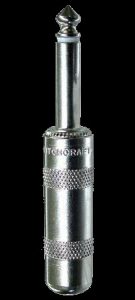 .
.
Reliability
This is mainly about the 1/4″ plug and the solder joints (which we can’t see). It doesn’t hurt to look at construction techniques, strain relief, and workmanship. But we always come back to the 1/4″ plug, and we still have not seen anything better than the old Switchcraft 280 plug. The small size is nice (and unpretentious, no frills), and these little things will take a beating.
.
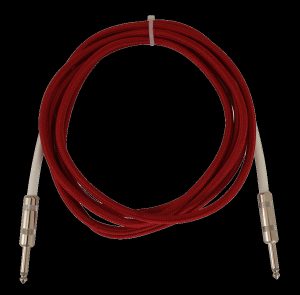 .
.
Flexibility
When coiling up a cable, you want something soft and flexible that coils easily without kinking up. Flexibility also makes cables attractive and safe, laying flat on the floor looking nice, without presenting an ugly kinked up trip-hazard underfoot. You may hear that a stiffer cable it more rugged. This is technically true, but how often have you seen the outer jacket of a cable be destroyed from not being rugged enough? We haven’t either.
.
.
Cost
 Always an issue. Despite all the hype out there, you can get a good 15 foot guitar cable for $10 that has good connectors, good workmanship, and uses nice flexible cable.
Always an issue. Despite all the hype out there, you can get a good 15 foot guitar cable for $10 that has good connectors, good workmanship, and uses nice flexible cable.
.
.
Bottom Line
We have yet to see anybody be able to tell the difference between a $10 cable and a $200 cable when blindfolded.
This is very important. We “see” with our eyes when we want to believe something. This reminds me of a funny encounter we had…
A fellow once protested to us “well maybe I can’t hear the difference blindfolded, but I know my (fill in the blank) cable sounds better!”
Yes, if you spend $200 on a cable, you WILL believe it sounds better! You have to, or you feel like an idiot.
But really, it don’t sound better.
.
 So when somebody claims they can hear the difference, challenge them to a blindfolded A/B test. (If they can hear the difference blindfolded, PLEASE LET US KNOW!!!)
So when somebody claims they can hear the difference, challenge them to a blindfolded A/B test. (If they can hear the difference blindfolded, PLEASE LET US KNOW!!!)
Or better yet…as we always say…try it yourself. Don’t trust your opinions to salesmen, or experts, or even us. The best, and only final judge of anything should be your own ears.
